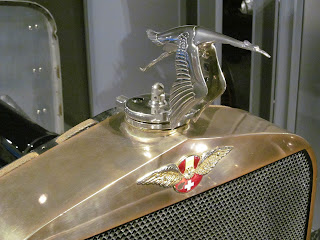Ken Purdy, writing in the early 50s about that select group of cars already considered classics, noted that Americans tended to confuse the Hispano-Suiza with the Isotta Fraschini*. The cars shared the same 1920s heyday and a similar clientele (movie stars, moguls, crowned heads), and while there were some sports models in both lines there was rarely anything you'd call modest, either in size or ambition. Both Hispano and Isotta were the kind of cars that silently and smoothly conveyed partygoers from Paris to the French Riviera in F. Scott Fitzgerald's stories during those brief years of sunny optimism between the end of a great war and the beginning of an economic collapse...
Hispano-Suiza, which was credited with creating the first sports car before World War I, cemented its place in history by making the most advanced aero engines in that war. Swiss engineer Marc Birkigt obtained financing in Spain and founded a factory there in 1904. King Alfonso XIII of Spain was a patron, and the company named its first sports car after him. The short wheelbase version below featured a 4 cylinder T-head engine of 3.6 liters developing 64 hp, making it a bit more efficient than the similar Mercer Raceabout from the same era. Top speed off the showroom floor was 75 mph while race-tuned versions hit 90, and that was flying in 1912. Soon enough Hispano was involved in real flying. A factory in France followed, and that's where the pioneering aero engines were first built, establishing the single overhead cam head design for a water-cooled V8 which was followed after the Great War by the inline six which appeared in Hispano's automobiles.
Few Hispano-Suizas would ever be described as compact or nippy, but this short wheelbase version of the T15 King Alfonso roadster managed to hit those marks. The long wheelbase version also from 1912, in gray below it, gave a taste of the grandeur that would follow.
Hispano-Suiza's stork mascot paid tribute to the squadron emblem of WWI French fighter pilot Georges Guynemer…
The H6 engine block and head were fabricated from aluminum, and featured a single overhead cam as well as a crankshaft milled from a single steel billet, and which ran in seven main bearings. Originally displacing 6.6 liters, it grew to 8 liters for the H6B and this H6C, where it developed 190 horsepower at a leisurely 3,000 rpm.
This H6C chassis from 1928 closely resembles the one that won a $25,000 bet between Paris coach builder Charles Weymann (famous for patented fabric bodies) and Fred Moskovics, the president of Stutz in Indianapolis*. The bet centered on which car would win a 24 hour match race at the Indianapolis Motor Speedway. The 8 cylinder Stutz Blackhawk, also a single overhead cam design, gave away 3 liters to the Hispano, but was lighter and better suited to Indy. The race was decided when the Stutz broke a valve in the 20th hour. The details of the race, and a subsequent 4 hour contest which a Stutz won, are well told on the web site for the Revs Institute, which houses the two examples each of the Alfonso Hispanos and H6C pictured here...
The rear view of Kellner's H6C sums up why the coach builder catalogued this body style as a skiff. Steering was on the right, as it was for most prestige cars in France and Italy during this period...
The most striking Hispano from this period (or any period, really) was the Xenia*, commissioned by Andre Dubonnet and named after his late wife. Built on a 6 cylinder H6B chassis in 1938, it featured Dubonnet's patented independent suspension front and rear (a first on an Hispano, and also licensed to GM and Alfa Romeo), and a spectacular, streamlined body with sliding doors and sweeping curves which extended into the wrap-over side windows, and a panoramic windshield of the type that appeared on GM cars a decade and a half later...
This creation, designed by Jean Andreau and built by Saoutchik, seemed to predict the jet age, and a future in which technology might solve all of mankind's problems, not unlike the exhibits at the 1939 New York World's Fair. Sadly, the Xenia would remain a solitary prototype for that future. Two years before it appeared, civil war broke out in Spain, Hispano-Suiza's first home, and two years after it appeared, France was invaded by Germany. Other than a small number of cars built by the Spanish factory during and after the civil war, and a few cars built by a subsidiary in Argentina, the Xenia might have served as Hispano-Suiza's closing automotive statement to the world.
*Footnotes: For more on the Isotta Fraschini, see "Forgotten Classic---Isotta Fraschini 8C Monterosa: Sunset for a Dream" in these posts for Sept. 4, 2016. The products of Stutz and other Indiana manufacturers are surveyed in "Looking Back: When Indy Was Indie" from Sept. 1, 2015. And the Xenia appears twice, first in "One of One: A Brief History of Singular Cars" from Sept. 7, 2015, and more recently in "Roadside Attraction: Rolling Sculpture at the North Carolina Museum of Art" from Dec. 31, 2016.
Photo Credits:
Top: the author
2nd thru 4th: Ian Avery-DeWitt
5th thru 7th: Paul Anderson
8th & 9th: Ian Avery-DeWitt
10th: car-reviews.com
11th & 12th: pinterest.com
13th: wheelsage.org
14th: George Havelka














No comments:
Post a Comment